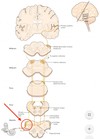auditory function and balance Flashcards
central auditory pathways: list the main structures in the central auditory pathways and their functions, explain tonotopic mapping, and identify the part of the pathway involved in auditory reflexes
two types of hair cell and relative abundance
inner hair cell (less abundant), 3 rows of outer hair cell (30x more abundant)
where do most afferent projections (signal from cochlea to brain) project from and function
inner hair cells (provide sensory tranduction)
where do most efferent projections (signal from brain to cochlea) connect to and function
outer hair cells (provide energy to mechanically amplify low-level sound entering cochlea)
diagram of inner and outer hair cells in Organ of Corti

source of energy for active processes by which cochlea has sensitivity and sharp frequency selectivity
electromotility
how does electromotility produce energy
body of outer hair cells shortens and elongates when internal voltage is changed, due to the reorientation of the protein prestin
where do hair cells form synapses with sensory neurones
in cochlear (spiral) ganglion
what does each ganglion cell do
responds best to resonant frequency of basilar membrane in same area, forming tonotopic map
define tonotopic map
sound-location map where low frequencies are ventral and high frequencies are dorsal (spatial organisation of response to frequency is preserved throughout pathway)
where is tonotopic mapping present
cochlear nucleus
what conveys information to cochlear nucleus
nerve fibres
diagram of ear to primary auditory cortex

what does the dorsal cochlear nucleus do and how
locates sound in vertical plane due to high frequencies producing intensity differences between the two ears
what are spectral cues and how are they produced in dorsal cochlear nucleus to locate direction of sound
high-frequency sounds produce interference within body; ears detect and affect differently sounds coming from different directions due to asymmetrical shape (spectral cues)
what does the superior olivary complex do
compares bilateral activity of cochlear nuclei (from both ears)
where is the medial superior olive
pons (medially)
what happens in the medial superior olive, and how it does this
interaural time difference in horizontal plane is computed (sounds are first detected at nearest ear before reaching the other; a map of interaural delay can be formed due to delay lines in medial superior olive)



